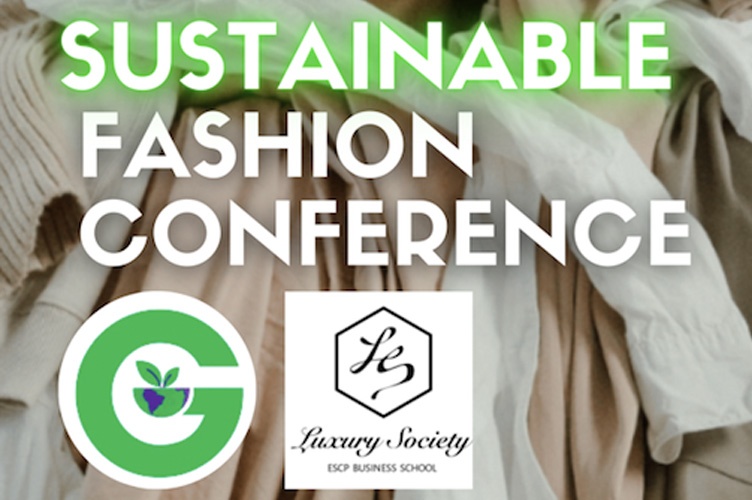On 8th March 2022, two of ESCP Business School’s London Campus student societies, GEA Sustainability and the Luxury Society, organised a Sustainable Fashion event to create awareness and highlight the importance of making a difference in what is widely believed to be the second most polluting industry in the world.
According to UNCTAD, some 93 billion cubic metres of water – enough to meet the needs of five million people – are used by the fashion industry annually, and around half a million tons of microfibre, which is the equivalent of three million barrels of oil, are now being dumped into the ocean every year. More information on the UN drive to highlight the environmental cost of staying fashionable is at UN News.
Sustainable fashion is a term for a movement and process of promoting and supporting change in fashion production, distribution and disposal that is most considerate to the environment and society. This is in terms of reducing the environmental impact through sourcing, manufacturing and designing clothes with the smallest carbon footprint.
Two of the event’s guest speakers, Nadege Solowski and Suzanne Rankin-Dia, came from the London College of Fashion. They were the lecturers in fashion and sustainability in the International Preparation for Fashion programme. The third guest speaker was Katarina Rimarcikova, a cross-disciplinary creative design practitioner and entrepreneur with a focus on sustainability, circular design, and responsible business models.
The attendees found the Sustainable Fashion event dynamic, innovative and impactful. The speakers engaged with the students throughout the conference, with Suzanne Rankin-Dia commencing by asking what sustainability meant to them, the various answers including:
- The art of innovating and creating, while preserving the environment in a durable way.
- Avoiding the depletion of natural resources.
- Using resources at a rate that allows for their natural regeneration, ensuring that future generations have the same quality of life that we do.
On International Woman’s Day, it felt important to shed light on the challenges women face as garment workers. Indeed, most of the exploited employees in sweatshops are women: 85% in Bangladesh, and 90% Cambodia. In an extract from the documentary The True Cost (2014), students could see the challenges the garment workers face daily. They do not earn a living wage, do not have a safe working environment and risk long-term health issues due to the chemicals used in the supply chain process. Even though this is a widely known issue of the fast fashion industry, there has been little change in recent years to remedy one of the features of modern slavery.
Currently, the fashion industry employs one in six people worldwide. Unsurprisingly, it has an important impact on various spheres: environmental, economic, social and cultural.
Most students are only familiar with the negative environmental and social impact of fast fashion companies, and were keen to learn about the other challenges on the way to Sustainable Fashion.
Nadege Solowski shared her insights on the latest cultural issues in the fashion world. Indeed, when it comes to the fashion industry, we often forget to discuss its cultural aspects. Fashion brands in particular are struggling to implement more inclusive approaches to fashion design, including having a more diverse audience and addressing the needs of non-standard consumers. Nadege commented on the fact that several brands, including Uniqlo, had only the sizes S to L available on the shelves of their shops (staff would need to go to the stockroom to get larger sizes). In addition, most brands continue to exhibit inconceivable (mostly photoshopped) body ideals, which leads to the development of eating disorders, especially among young people. Nevertheless, Nadege pointed out that, with the body positivity movement on social media, the fashion community is finally evolving on the issue and learning to become more inclusive. For instance, Victoria’s Secrets’ angels were replaced by more diverse women, with more diverse body types and ethnicity, so that every woman can identify with the brand.
Circular Economy has become one of the most relevant topics in the Sustainable Fashion development. Experts consider it the most viable option for large fashion groups. Katarina Rimarcikova explained that, at present, the fashion industry still follows a linear model: take, make, use and dispose. This model causes widespread environmental pollution and makes the fashion industry one of the biggest contributors to the climate crisis.
As an alternative, the circular model is a new system designed to eliminate the concept of waste in the making of garments, by always enabling the recovery and reuse of all materials at the highest value possible. By making the value chain of the fashion industry more circular, brands could easily reduce their volumes of waste and emissions.
In fact, the upstream value chain of household textiles, clothing and footwear consumed in the European Union is the fifth highest GHG emission pressure category. Therefore, if the brands were to reuse the large amount of textile clothes that were produced previously, they could majorly decrease their emissions. Indeed, the most sustainable garment is the one we already have in our closet.
The guest speaker concluded by sharing her favourite circular concepts and shops in London:
- The Restory - an on-demand service providing modern aftercare for luxury fashion.
- Hurr Collective - giving lenders the chance to monetize their pieces, and renters the chance to shine in them for a fraction of the retail price.
- BEEN London - an award-winning brand making accessories entirely from recycled materials.
Suzanne Rankin-Dia commented: "One of the biggest challenges of today is to re-educate consumers around the values of the products they buy."
Campus
